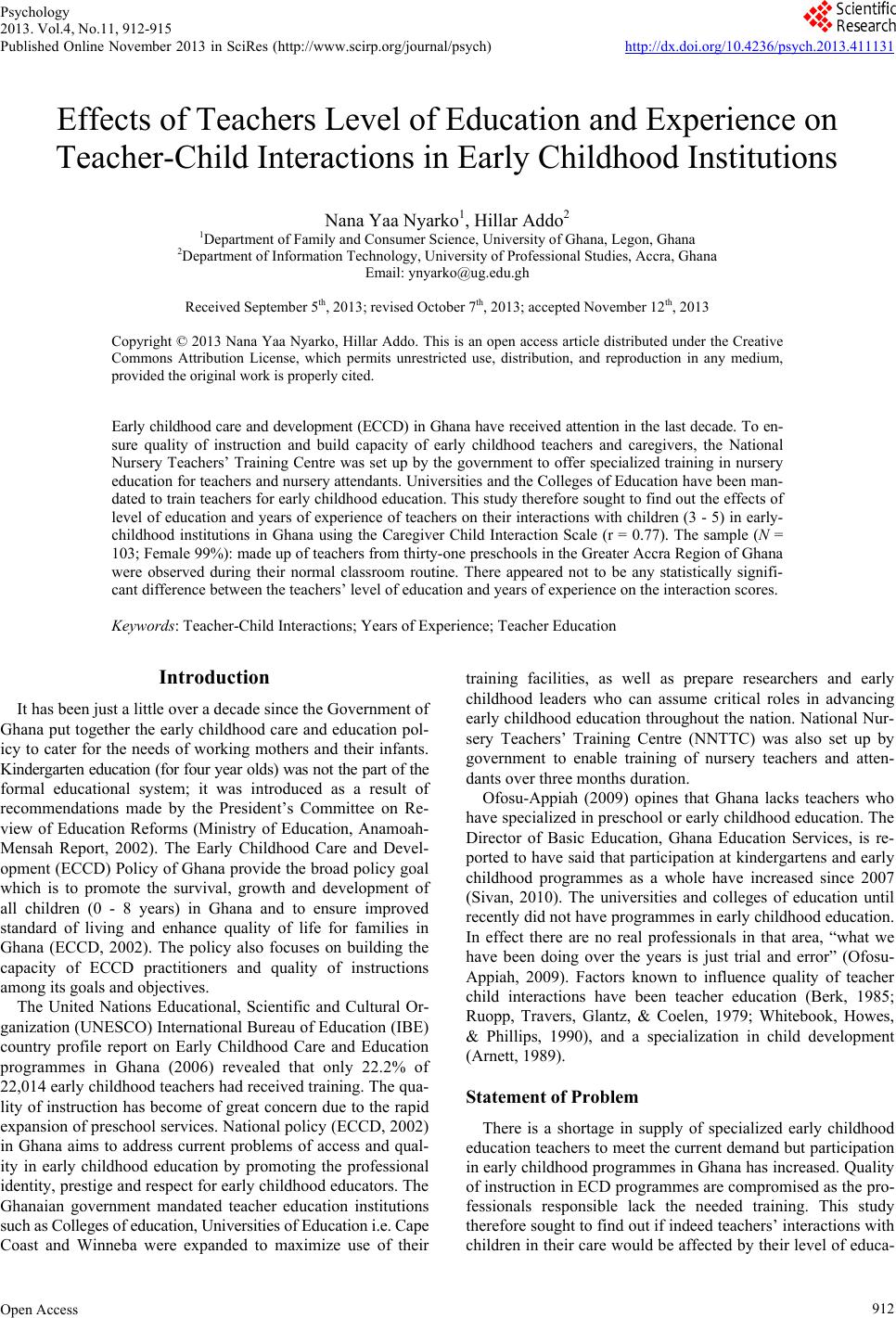
Psychology
2013. Vol.4, No.11, 912-915
Published Online November 2013 in SciRes (http://www.scirp.org/journal/psych) http://dx.doi.org/10.4236/psych.2013.411131
Open Access 912
Effects of Teachers Level of Education and Experience on
Teacher-Child Interactions in Early Childhood Institutions
Nana Yaa Nyarko1, Hil l a r A d do 2
1Department of Fam ily and Consumer Science, University of Ghana, Legon, Ghana
2Department of Information Technology, University of Professional Studies, Accra, Ghana
Email: ynyarko@ug.edu.gh
Received September 5th, 2013; revised October 7th, 2013; accepted November 12th, 2013
Copyright © 2013 Nana Yaa Nyarko, Hillar Addo. This is an open access article distributed under the Creative
Commons Attribution License, which permits unrestricted use, distribution, and reproduction in any medium,
provided the original work is properly cited.
Early childhood c are and development (ECCD) in Ghana have received attention in the last decade. To en-
sure quality of instruction and build capacity of early childhood teachers and caregivers, the National
Nursery Teachers’ Training Centre was set up by the government to offer specialized training in nursery
education for teachers and nursery attendants. Universities and the Colleges of Education have been man-
dated to train teachers for early childhood education. This study therefore sought to find out the effects of
level of education and years of experience of teachers on their interactions with children (3 - 5) in early-
childhood institutions in Ghana using the Caregiver Child Interaction Scale (r = 0.77). The sample (N =
103; Female 99%): made up of teachers from thirty-one preschools in the Greater Accra Region of Ghana
were observed during their normal classroom routine. There appeared not to be any statistically signifi-
cant difference between the teachers’ level of education and years of experience on the interaction scores.
Keywords: Teacher-Child Interactions; Years of Exp erience; Teacher Education
Introduction
It has been just a little over a decade since the Government of
Ghana put together the early childhood care and education pol-
icy to cater for the needs of working mothers and their infants.
Kindergarten education (for four year olds) was not the part of the
formal educational system; it was introduced as a result of
recommendations made by the President’s Committee on Re-
view of Education Reforms (Ministry of Education, Anamoah-
Mensah Report, 2002). The Early Childhood Care and Devel-
opment (ECCD) Policy of Ghana provide the broad policy goal
which is to promote the survival, growth and development of
all children (0 - 8 years) in Ghana and to ensure improved
standard of living and enhance quality of life for families in
Ghana (ECCD, 2002). The policy also focuses on building the
capacity of ECCD practitioners and quality of instructions
among its goals and objectives.
The United Nations Educational, Scientific and Cultural Or-
ganization (UNESCO) International Bureau of Education (IBE)
country profile report on Early Childhood Care and Education
programmes in Ghana (2006) revealed that only 22.2% of
22,014 early childhood teachers had received training. The qua-
lity of instruction has become of great concern due to the rapid
expansion of preschool services. National policy (ECCD, 2002)
in Ghana aims to address current problems of access and qual-
ity in early childhood education by promoting the professional
identity, prestige and respect for early childhood educators. The
Ghanaian government mandated teacher education institutions
such as Colleges of education, Universities of Education i.e. Cape
Coast and Winneba were expanded to maximize use of their
training facilities, as well as prepare researchers and early
childhood leaders who can assume critical roles in advancing
early childhood education throughout the nation. National Nur-
sery Teachers’ Training Centre (NNTTC) was also set up by
government to enable training of nursery teachers and atten-
dants over three months duration.
Ofosu-Appiah (2009) opines that Ghana lacks teachers who
have specialized in preschool or early childhood education. The
Director of Basic Education, Ghana Education Services, is re-
ported to have said that participation at kindergartens and early
childhood programmes as a whole have increased since 2007
(Sivan, 2010). The universities and colleges of education until
recently did not have programmes in early childhood education.
In effect there are no real professionals in that area, “what we
have been doing over the years is just trial and error” (Ofosu-
Appiah, 2009). Factors known to influence quality of teacher
child interactions have been teacher education (Berk, 1985;
Ruopp, Travers, Glantz, & Coelen, 1979; Whitebook, Howes,
& Phillips, 1990), and a specialization in child development
(Arnett, 1989).
Statement of Problem
There is a shortage in supply of specialized early childhood
education teachers to meet the current demand but participation
in early childhood programmes in Ghana has increased. Quality
of instruction in ECD programmes are compromised as the pro-
fessionals responsible lack the needed training. This study
therefore sought to find out if indeed teachers’ interactions with
children in their care would be affected by their level of educa-